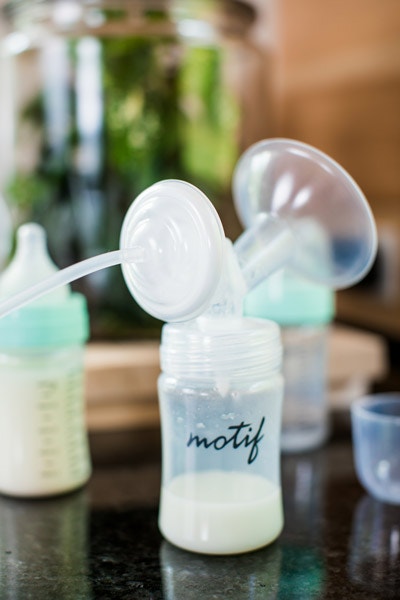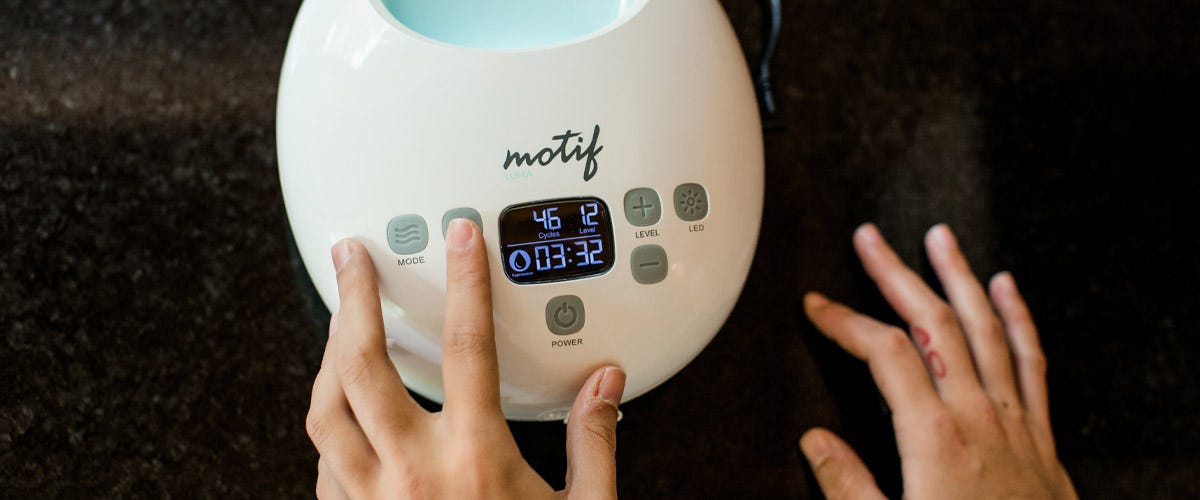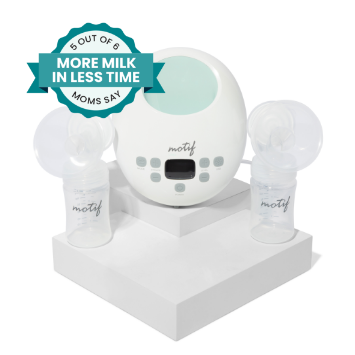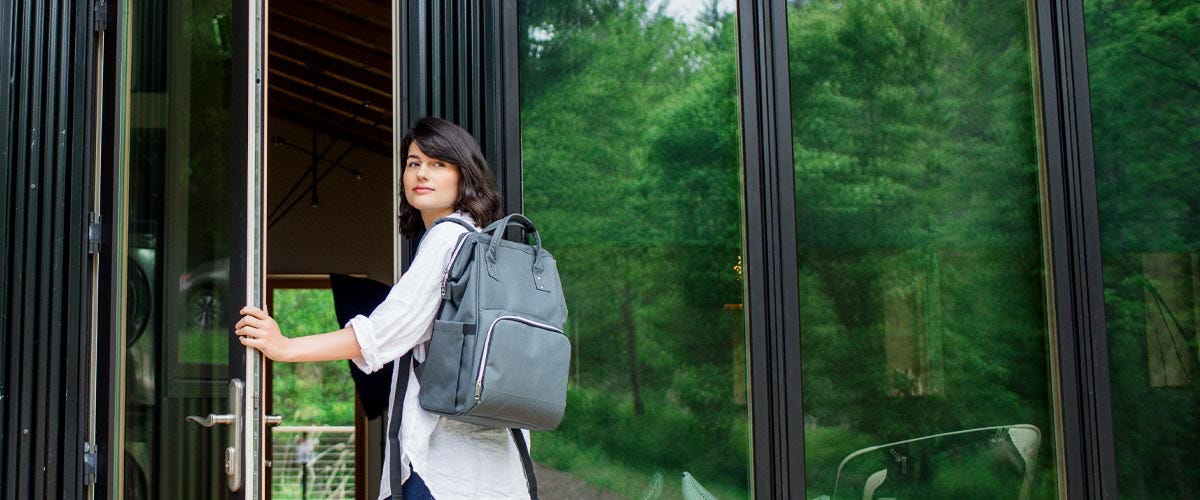How to Use Your Pump
Using your pump is a technique, a process. The steps involved are not to simply hook up, press “on” and crank things up to full power. In fact, it may be counterproductive, quite literally, and even painful, to pump without proper technique. The most optimal output is achieved with an intentional method to simulate the way a baby triggers milk release. Luckily, with a great pump and establishing a technique, pumping will feel much simpler!
1. Set Up
After washing hands and assembling the pump parts, the first step in starting the pump is to make sure the flange is centered around the nipple and areola, to prevent nipple-rubbing, with no gaping that would break suction.
2. Massage/Letdown Mode 1-3 minutes
Once ready, press the power button to on, and the first setting should be in “massage mode,” indicated by the hand symbol.
This is an important step not to skip, as it mimics a baby’s initial stimulation, gently stretching the nipple. This movement is the “big red button” for oxytocin release¹, the hormone that will trigger the milk-storing alveoli to contract and release. This is why this step is also known as the “letdown mode.”
The settings should be comfortable, the cycles faster, and the strength or level softer. This step takes on average 2-3 minutes. Some moms may choose to switch over manually to the next setting once they see milk, but others claim better output when they stimulate for longer durations.

3. Expression Mode 5-15 minutes
The expression mode is the main part of the pumping experience, taking 5-15 minutes to complete. Press the "Mode" button to manually switch from massage to expression. The settings should be adjusted to comfort, and attention paid to the flip in frequency vs. strength. Cycles should be longer, slower, and strength needs to increase. These two settings simulate the rhythmic drinking of a baby, balancing stimulation and strength.
Once these settings are selected our Luna pump will remember the settings from your previous session and automatically start up each mode on these levels.
4. Finish
After milk has stopped expressing, turn the pump off and then gently break suction from the breasts. This can be done by gently tilting the flanges downward, or using a free hand to indent the breast around the seal. Being gentle will help prevent discomfort or pain upon removing. Store² your milk in the refrigerator or freezer in their proper containers. Wash and sterilize pump parts that come in contact with you and/or your milk, not the tubing.
Washing/sterilizing only has to be done once a day if parts are kept in the refrigerator in between uses!
Common Breast Pumping Issues
Stress and Tension
Something important to keep in mind while pumping is to relax the body. Taking a few deep breaths, visualize milk flow leaving the breasts, and even listening to classical music, have all been shown to increase overall output. This is due to the type of response the body needs to have milk release triggered. Many mothers have said how they dread the “job” of pumping, watch the bottles the entirety of their session, along with other statements that all read a level of negativity and stress. Breastfeeding, in general, is a very hormonal function, relying on not only physical stimulation, but emotional as well.
I often use the analogy of making tears: we either tear up because we get something in our eye, say mascara, and the tear ducts release, or we have an emotional response, and the dam bursts. Combining a physical and emotional stimulation cocktail will only increase the body’s response to milk release.
It is almost never about milk production and supply when it comes to difficulty with responding to a pump, but rather the pump is simply not as cute as your baby. Have a picture near you of your baby, or even a blanket that smells like him or her, to lead your concentration away from pumping and onto who you’re selflessly supplying for. Perspective!

Pain and Discomfort
The chemical response for oxytocin, the letdown hormone, is blocked upon the experience of pain to a degree. For some, lactation and pumping is not affected when they are in pain, but for many, it is the tip to the scale that inhibits the desired output for their stash. It is important to address any damage to nipples, improper flange sizing, and strength settings, among other factors, such as recurrent engorgement, mastitis, and thrush, which can all be quite painful and a sign of something worth investigating.
Important note: Waiting to feed or pump until breasts feel full can be painful and problematic for long-term supply. A segue into another important factor: Time.
Time
A usual culprit, time, can be a cause for problems when it comes to pumping. As for scheduling pump sessions, it needs to as often as baby is feeding. If your baby is still feeding every 2-3 hours on average, or should be, then pumping for any feedings missed directly at the breast should be the goal.
Sleeping longer stretches, 4-6 hours or more, is a potential problem for the breastfeeding mother if still within the first year of breastfeeding. Milk not expressed within a 4+ hour period has a high amount of feedback inhibitor of lactation (FIL)³, a protein that monitors demand in order to adjust supply needs. If unused within a certain time, regulation of milk supply to the wrong amount will affect overall supply, especially if done repeatedly. If baby is healthy and can go longer stretches at night without cause for concern, pump at least once in the night.
A brief note on exclusive pumping: especially if exclusive pumping from day one for various reasons, it is more about stimulation than supply the first few weeks. Frequency/number⁴ of times in a 24 hour period should be increased, especially during weeks 2-3, to imitate cluster feeding that would normally occur if feeding on demand directly from the breast, which sets the threshold for long-term supply needs.

In other words, it lets the body know there is a customer who isn’t going anywhere, anytime soon! The average number of times a newborn would feed is approximately 10-12 times in a 24 hour period. Frequency is especially important for premature (38 and less) situations. It may be helpful to prime the breasts with the pump, and hand express for better output during this time.
Other Potential Problems
Hands-free bras are an ingenious invention, allowing mothers to multitask or relax from having to hold the flange/bottle setup the entire time. Moms can now pump on their commute, continue to work on the clock, care for another tot running around, or simply snack and drink while they pump. As wonderful as it is, a simple problem can be the bra allowing a slight slack in the flange fitting, which causes a break in the seal, even to a small degree. It can also cause fitting and centering to be off, with mom not noticing until its painful. Take time for proper fitting so as not to waste precious time or cause tissue damage.









